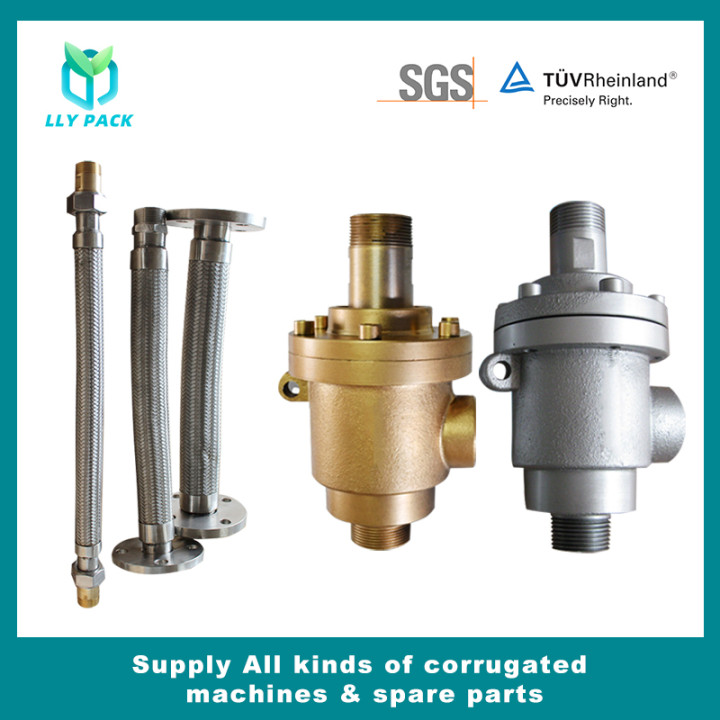At present, the adhesive used in automated paperboard production lines (or single-sided machines) at home and abroad is commonly referred to as "raw rubber." The so-called "raw gum" refers to no adhesive force at room temperature, it will be heated to a mature gum by the high temperature on the paper, and it will have adhesive force. The production method mainly uses starch (mainly corn starch, and also other starches such as tapioca starch, wheat starch, etc.), and is made into adhesive by two-step method. The disadvantage of this type of pure starch adhesive is that the strength and hardness of the paperboard produced is not high, the moisture resistance is poor, and it is not water resistant.
The optimum viscosity of the automated cardboard production line (or single-sided machine) adhesive should be controlled between 45-95 seconds (measured with 4 cups), and of course between 30-300 seconds. Actually, manufacturers use a variety of habits. Differently, the viscosity of the glue used varies greatly, the minimum viscosity is about 30 seconds, and the maximum is about 300 seconds. Why is the best viscosity between 45-95 seconds? This is because: the viscosity is too small, the rubber roller is not glued, and when the double-sided compound is used, the permeation is too fast; the viscosity is too large, the fluidity is poor, the coating is uneven, and the permeation ability is not strong. In both cases, the adhesion is not caused. it is good. Therefore, in practical use, the viscosity of the glue should be controlled within a suitable viscosity range.
So how to adjust the viscosity of the glue? It should first understand what is the important factor affecting the viscosity of the glue and how it affects it. The influencing factors and impacts are as follows:
First, the carrier starch (or powder), viscosity; carrier starch (or powder) less, with less, the viscosity is small.
Second, the total water added, the viscosity is small; total water, viscosity.
Third, the use of borax, viscosity, large amount; low viscosity, low viscosity.
Fourth, the glue, the longer the mixing time, the smaller the viscosity; the shorter the stirring time, the greater the viscosity. In addition, under the same stirring time, the faster the mixer speed, the smaller the viscosity.
5. The use of caustic soda at a level below 3.5% of the total starch has little effect on the viscosity of the glue. If the amount of caustic soda is too large, the viscosity of the glue is extremely large and forms a mass that cannot be used.
Sixth, the viscosity of starch itself is also different. Starch contains branched and amylose, amylopectin, viscosity, amylopectin, and low viscosity. Different origins and different varieties of corn, containing amylopectin different processed starch, the viscosity is very small.
Usually, for a company, the equipment used for making glue must be constant, and the speed of the mixer must be constant. Due to the constraints of the production line, the water used for the glue is basically the same, that is, the amount of total water added is constant, and the amount of borax is also used. Invariable, so that in the actual process of making glue, only need to increase or decrease the amount of carrier starch, to master the appropriate mixing time, you can adjust the viscosity of the glue in the optimum viscosity range. If there is a change in the viscosity of the starch itself, it is only necessary to appropriately increase or decrease the amount of the carrier starch, so that the viscosity of the glue can be kept substantially constant.
When people talk about the viscosity of glue, it's easy to confuse it with good adhesion. Adhesive viscosity and adhesiveness are two different things. Viscosity and adhesion are two completely different concepts. In the case of adhesives for paperboard production lines, the viscosity of the glue does not substantially affect the bond strength over a wide range of viscosities. It is by no means the higher the viscosity of the glue, the higher the bond strength. On the contrary, it has good flowability and good permeability. , that is, the glue with small viscosity is used in high-speed automatic production lines, and the adhesive effect is better.
Different papers have different requirements for the viscosity of the glue, the paper is rough, easy to penetrate, the glue with a slightly higher viscosity is used; the paper is fine and the glue with a small viscosity is used. In particular, imported “cow cardboard” uses high-permeability plastics.
In different seasons, the temperature and humidity are different, and the requirements for glue are different. When the temperature is high and dry, the amount of water should be appropriately increased: when the temperature is low, the amount of water should be appropriately reduced. When the amount of water is changed, the amount of the corresponding carrier starch should be appropriately increased. Keep the viscosity of the glue basically unchanged. Here, the viscosity of the glue is basically the same, and it does not mean that the formula of the glue is not changed. On the contrary, the glue formulation should be changed according to different factors such as the paper, the season, and the viscosity of the starch itself, and it can be adjusted at any time, but it is not appropriate. Make big adjustments. Absolutely not changing formulas is not science. Different batches of starch may have different viscosity levels. If necessary, the formula should also be adjusted. It is only necessary to increase or decrease the amount of carrier starch.
In short, the plasticizers should make out the principles of plasticity according to actual needs, be flexible and flexible, and can arbitrarily adjust the viscosity of the plastic to meet the actual needs of cardboard production.
EnglishEspañolPortuguêsDeutschहिंदी日本語ខ្មែរNederlandsالعربية한국어मराठीMalagasyItalianoPolskiSvenskaελληνικάPусскийภาษาไทยTürkShqipMagyarViệtSamoaМонголMaltiIndonesia FrançaisMelayuҚазақшаYorùbáবাঙালিעִברִיתGàidhligSomaliEesti keelKreyòl Ayisyennorskčeštinaفارسیతెలుగుမြန်မာBosanskiMaoriქართულიRomânăбеларускіУкраїнськаతమిళGaeilgeSuomalainenپښتوລາວհայերենSlovenščinaFilipinoO'zbekÍslenskaייִדישLatviešuGalegoFryskनेपालीKurdîCatalàбългарскиHawaiianHrvatskiਪੰਜਾਬੀWong JawaKiswahililëtzebuergeschisiXhosaEuskalSundaZuluગુજરાતીТоҷикӣ
- Casa
- Chi siamo
-
Elenco prodotti
- Linea ondulata
- Macchina ondulata >
-
Ricambi a macchina ondulata >
- Giunto rotante
- Pettine per il marcatore di scivolone
- Pastiglie dei freni
- Pompa diaframma per colla
- Stripper di carta scarica
- Chuck di espansione
- Tubo flessibile in metallo
- Mola
- Nastro per splicer
- Rullo ondulato
- Lama di taglio
- Cintura di trazione del ponte sopraelevato
- Ruota del sole
- Cintura del trasportatore
- Lama da taglio NC
- Trappola a vapore
- Cilindri pneumatici
- Freno pneumatico
- Air Bellow Spring
- Pompa a vuoto ad anello d'acqua
- Lubrificante a macchina ondulata
- Distanziatore di gomma
- Distanziatore placcato in titanio
- Flexo Stampter Slotter
- Macchina della stampante Flexo >
-
Parti di ricambio della stampante >
- piastra di rame
- PIASTRA DI STAMPARE
- Pompa Aro.
- Pennello in acciaio e ottone
- Filtro in inchiostro
- Doctor Blades.
- Copertura dell'antico
- Lama di slotting.
- Nastro in fibra
- Cornice sospesa
- PET PRESSIONE PET con film
- Cuscino di stampa r e bak
- Ruota di alimentazione
- Un modo portante
- Die board rotary.
- Pompa a diaframma singola
- Blocco finale con condotto a inchiostro
- Diaframma in gomma
- Valvola di Duckbill
- Freno della frizione magnetica
- Striscia di scanalatura sospesa
- Macchina da imballaggio >
- Macchina per cartone >
- Parti della macchina di cartone. >
- Cinture a doppia facciatura.
- Cucitura del sistema di incollaggio >
- Lama di taglio di cartone >
- Lama in acciaio di tungsteno >
- Mola
- Stripper di rifiuti
- Lama della macchina per imballaggio >
- Apparecchiatura pre-pressione >
-
Lama di taglio industriale >
- Lama da sega circolare di taglio delle piastrelle
- Lama della sega da taglio in metallo
- Lama segale da taglio in legno
- Lama segale da taglio del cibo
- Lama da taglio in fibra
- Blade di chipper
- Stampo pieghevole
- Lama per la macchina da taglio vegetale
- Lama sottile in acciaio
- Lama da stampo Tsukatani
- Lama da stampante
- Blade della macchina maschera
- Slitter Rewinder Blade
- Lama tmr
- Lama circolare del tabacco
- Roll Shear Blade
- Coltello dentellato per imballaggio
- Blade a fascia da taglio di carta
- Lame del dottore
- Lama rotonda
- Tre buche lama
- Lama ceramica
- Bastello a banda Blade per tessuto
- Bastello a banda Blade per spugna schiuma
- Bastello a banda per la scissione della macchina
- Lama del coltello a banda per carta
- Porta della lama
- Lama di taglio industriale
- Taglierina
- Smerigliatrice angolare
- Blade Shredder
- V Grooving Blade
- Forbici elettriche
- CNC Machine Blade & Tools
- Lama di trasformazione alimentare
- Notizia
- video
- Contatti
- Invia domanda










